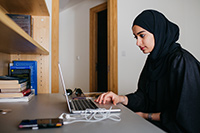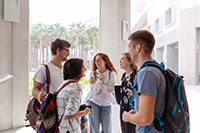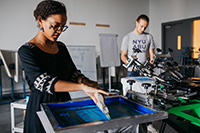Academic Convocation
November 8, 2020
Watch the recorded event
Good afternoon, NYU Abu Dhabi. Thank you for being here to welcome our new Provost, Arlie Petters and to reflect on the state and future of our institution. Welcome, Arlie, and thank you for your forward looking remarks. I want to thank all who have made this occasion possible, and particularly our fantastic events staff and our inspiring speakers and musicians. There is more wonderful music after me, so that is an incentive to hang on till the end of my remarks.
My first State of the Campus address is eight months late, and I’m sorry. A year ago, we began a transition initiative to ascertain the interests, the potentials, the dreams that propel our learning community. The process would inform a State of the Campus address at my Inauguration in March 2020, which would mark our tenth anniversary and help launch us into our second decade. Just three months later, the Inauguration was the first event we canceled as we began to adjust to an unsparing pandemic.
The work of so many to prepare for a beautiful Inauguration has not been lost. Our five Transition Working Groups of faculty, staff, and students energetically sourced ideas and feelings about the university across our campus. The groups took on big picture topics that could help us understand the state of NYUAD:
- The evolution of our academic institution
- The interaction between the disciplines and interdisciplinarity
- Campus culture
- Knowledge infrastructure – and
- NYU Abu Dhabi as an anchor institution for the UAE
In February the groups sent me five crisp reports, and I read them with relish as they were full of profound thought and passion about our mission. That very week, our collective priorities had to shift to safeguarding the health of our community and maintaining academic continuity as well as we could. Ever since, however, I have kept going back to the reports, as they are a hopeful record of what NYUAD was at the cusp of pandemic. All that is still here, even if we have been living under shifting stars, and will have to for a while longer.
The Transition Working Group reports have been given to the Academic Strategy Taskforce that Arlie has initiated, and they will be made available to our entire community this week. They are high-level, generative documents, with observations and suggestions decanted from your collective inputs, and will help guide the development of our academic strategy. The recommendations of the academic strategy task force in turn will let us chart the next steps on our trajectory to become a world-class university in and of Abu Dhabi, in and of NYU, and in and of the world.
The reports provide ringing endorsement of NYUAD’s foundational vision: to be a resolutely international learning community that is grounded in Abu Dhabi, and that combines an innovative liberal arts education with the research capacities of a major global university, NYU, and would eventually build graduate programs. They acknowledge that while no university is perfect, NYUAD has the people, the values, and the infrastructure to fill out our founding vision. This is the task of our second decade.
Thanks to your resilience, I can finally give that State of the Campus address. If it is not quite what I would have said on March 9, the university values encapsulated in the reports have been so evident during the pandemic that this speech is not different in essence from what I drafted in February. One thought, however, stands out more clearly now. NYUAD’s extraordinary endurance not only says a lot about our caring and determined community, but also exemplifies what a University is as an enduring institutional form. I would like to unfold that convergence between NYUAD as a resilient learning community and the University as a civil society institution of great longevity.
It may seem strange to talk about the state of our campus when about half of us are not here and this event is mostly virtual. How are we a campus in our Remote Plus dispensation? I’ve always thought of campus as a metaphor as well as a place. Campus in Latin means field, and those iconic green spaces on university campuses have always been more than squares to hang out or fields to throw frisbees. From Plato’s grove outside Athens to Thomas Jefferson’s University of Virginia, from Tsinghua University’s magical gardens to our own Highline, university greens have the metaphoric resonance of fields for cultivation. Even in our dispersed condition, we have maintained that sense of our institution as a site of growth.
Here, we grow! The truth of our tenth anniversary theme is self-evident.
Here we grow in two senses of the word. We grow as individuals – as learners, as scholars, as artists, as community members, as purposeful human beings. And as a university we grow the way gardeners grow living things – we grow ideas, knowledge, inventions, beauty, insight, empathy, and most importantly, we enable our students to grow.
In all these ways, NYUAD continues to grow, even if it isn’t easy. For a youthful institution, a walloping pandemic and global economic crisis pose special risks, but our campus has weathered this double storm front with heroic ingenuity and persistence. Despite the wearying challenges, we have maintained momentum in the three core areas of our mission: teaching, research, and making our community a model and engine for a better world. You have heard me speak about all of our students, including first years, who decided not to let the pandemic put their education on hold; the hundreds of courses our faculty have taken online with creativity and grit; the powerful research they have launched or maintained despite constraints; the leadership of our student government; the determination of our staff to maintain academic continuity; the vigor of our campus life and arts programs that keep us connected. We say we have Zoom fatigue, but we continue to Zoom in.
We have remained a campus wherever our community is. The physical part on Saadiyat is coming back to life thanks to the phenomenal direction of our Return to Campus groups and to the tireless work of the staff who keep us safe, healthy, and nourished in body and spirit. I am grateful to all of you for making these improvements possible by adhering firmly to the health and safety rules. As they say so well in this country: We are all responsible. We have been, and we will be.
We have gained fresh momentum in the third part of our mission: that of being an intentional force for good in the world. Our robust conversations about diversity and belonging on campus are bridging concerns of the world to those of our community as never before. These dialogues are good, hard, and necessary. The Transition Working Group on Campus Culture asked for a more purposeful approach to inclusion and equity on campus. Although the group found contentment about many areas of our community life, it noted that not all feel equally welcome or heard.
This work of inclusion has been accelerated by our community’s active response, with courageous leadership from our students, to what should be a simple truth – that Black lives matter. The Implementation Committee on Race Diversity and Belonging is listening with open ears, minds, and hearts to our community, and helping devise processes that should yield change.
As we strive for that more perfect campus, we must acknowledge two realities. First, the work is hard because it addresses problems that are old and pervasive in the world. We will not have instant success, but we can be hopeful because NYUAD is designed to recognize the humanity of all. Second, the work is the job of all of us, not just of the remarkable leaders of our offices and committees dedicated to it. Together, we can use our own fabled diversity to catalyze a more peaceful and just world.
In sum, to deal with the current constraints of the pandemic we are drawing on the world’s only resource that is truly renewable: human curiosity, knowledge, and creativity. That resource is uniquely concentrated in universities because they are designed to magnetize the most curious, creative, and determined minds to them. It is that concentration of intellect and imagination that makes the university an enduring and adaptable institution. From Bologna to Oxford, from Fez to Beijing, from New Haven to Singapore: universities have maintained their essential mission for centuries, even if their content evolves with society.
Emphasizing the endurance of the University may be counterintuitive as it faces so many challenges – from managing student health to securing solvency to surviving the advent of massive online instruction. Universities are struggling to figure out how to restore old capacities and launch new ones after the pandemic, but they are doing it. Universities have overcome existential threats throughout history – from war and persecution to pandemics and cultural conflict. They are among the most enduring organizations humans have invented. If they are not perfect, it is because they stand in an enduring relationship to the societies that create and support them.
Even though we are justly proud of NYUAD’s distinctiveness, we have inherited the legacy of the University as an adaptive and resilient organization that brings incomparable value to society. Great universities come in many shapes and sizes, but if you think about what they have in common you can see that NYUAD is already a mighty member of the species.
What are the elements that constitute the enduring form and value of universities?
First, they are stewards and generators of any forms of knowledge and methods of inquiry – and those will change over time. The medieval universitas – a word indicating a complete community of scholars, a whole of what can be known – was designed to welcome any field of thought. For many centuries it privileged religious, textual, and mathematical forms of knowledge, but that range has expanded and shifted over time into engineering, social science, and the arts. No university does everything, but each is universal in the scope of what it may study and teach.
Second, great universities exist by their students. The original purpose of universities is to equip a next generation of human beings with knowledge and methods for seeking truth so that they may live lives of civic contribution and personal fulfillment. The highest purpose of universities exists in delivering such graduates to society. Every one of our seven graduated classes is living proof.
Third, universities advance knowledge even as they transmit it, and their governance is structured to make sure they can drive research. The primacy of teaching can be a flashpoint for universities with high research ambitions, but most faculty know that novel ideas are born in teaching, and that active research makes education sing. A great university’s research excellence stands in a reciprocal relation to its educational remit, and this is especially evident at NYUAD. NYUAD has one of the liveliest undergraduate research programs I know, thanks to the gregarious curiosity of our students and the inspired leadership of our faculty.
Fourth, if we agree that the best universities advance universal knowledge and educate students in it, it is easier to see that the idea of a liberal education is present in all of them, and not only in the exceptional American form of the standalone liberal arts college. While the beating heart of NYUAD is an innovative version of such a college, we have intentionally embedded it in the plenitude of a research university – just as great universities from Princeton to Arlie’s former institution have always done.
Even European universities never disclaimed the ideal of liberal education, with its roots in the medieval curriculum of language, mathematics, and music. More important than the term liberal arts is its purpose: helping students develop habits of thought, inquiry, and empathy that prepare them for living in an unpredictable world, and to gain skills that can launch them onto trajectories of leadership, fulfillment, and contribution. Liberal education means learning in breadth and in depth, for perspective and expertise, for method and data. The difference between an American liberal arts education and an arts and sciences program in Europe or Asia is one of degree. The greatest universities see themselves as engines of broad human development as well as expertise.
In 1916, when the Kingdom of Mysore created the first modern Indian university that was independent of the British Empire, it honored the goals of liberal education while fostering research and offering professional degrees. The first commencement speaker of The University of Mysore, Sir Asutosh Mukherjee, praised this direction. Sir Asutosh was a great champion of education and a university rector from Bengal. His graduation speech is a meditation on the enduring features and purposes of a great university, noting:
"We must realise that an institution of University rank must aim at a sphere of study and consequent influence as wide as the whole domain of human activity. It must frankly recognise the kinship of the arts and sciences and the inherent interdependence of all study and research, supplement theoretical by practical studies, and liberalise technical and professional instruction by organic connection with arts and letters."
Mukherjee had much to say about the balance universities must strike between their service to their home country and their participation in the international knowledge enterprise. This balance is a fifth feature of great universities, and one that is fundamental to our mission.
Mukherjee saw that to fulfill all of these functions universities need to be independent in what they decide to teach, who will do it, and how they will do it, and that they must have freedom to pursue academic inquiry wherever it leads, even if their products must also serve society. Universities need to be apart from the world, but also a part of it. This tension has sustained them for centuries.
Any university’s endurance depends on its capacity for renewal and innovation, and that capacity requires a fine balancing act between campus and society. That reality has implications. A university research portfolio should have a healthy balance between basic research driven by boundless curiosity and applied inquiry that attends to what the world needs or could improve now. At NYUAD we do both exploratory and applied research, even if, as Provost Katy Fleming has reminded us, application is core to NYU as a private university for public good.
To be of the fullest service to society today, great universities also strive for a curricular mix of undergraduate education, professional master’s degrees, and doctoral programs that prepare the next generation of knowledge creators. Not one of these levels of education should override the needs and prerogatives of the others. Today, we also welcome Carol Genetti, our new vice provost for graduate and postdoctoral programs. Welcome Carol! As our Master’s and PhD programs develop, our graduate student community will play ever more meaningful roles at NYUAD, in support of, rather than contradiction with, our great early history as primarily an undergraduate institution with hefty research.
Building a well-tempered, dynamic, curiosity-driven institution in the public service, and doing it the NYU Abu Dhabi way: that is the task of our second decade. We will have to choose what seeds to sow, but our field of possibility remains unbounded. Our future is ripe for work between the disciplines that makes more of what each of our fields can yield. There is tremendous opportunity to build forward on our existing research strengths, tackling challenges from a sustainable environment to improving public health, from enhancing cybersecurity to governing AI, from bending back the arc of inequality to fostering the arts as a resource for human flourishing.
I have said a lot because this is a pivotal moment in our evolution. Although the pandemic has unleashed untold misery, it will also clarify that universities are the wellspring of innovation, adaptation, and progress. It will clarify why knowledge matters, why education matters, why truth matters. It will clarify why universities endure, and that we will.
At ten years, NYUAD has proved itself to have the educational power, creativity, service orientation, and adaptability that has marked the greatest universities. We have established our presence in that cohort faster than any university in history, thanks to the vision of the leaders of this country and of NYU, thanks to our founding institutional leaders here, thanks to our steadfast Abu Dhabi partners, and above all, thanks to you – our faculty, students, alumni, and staff who are NYUAD.
But we have farther and higher to go! With what we all bring, NYUAD will continue its journey to become one of the most inspiring, most relevant, and most necessary institutions of its kind.
Here, we grow.
 Your journey to NYUAD starts here. Attend an application workshop or information session.Admissions Events
Your journey to NYUAD starts here. Attend an application workshop or information session.Admissions Events Live the possibilities. Be part of a dynamic community of students from over 115 countries.Take a Tour
Live the possibilities. Be part of a dynamic community of students from over 115 countries.Take a Tour